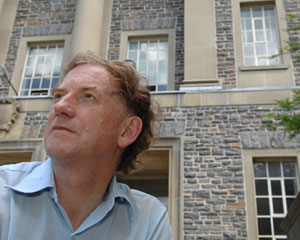 |
| Dal professor James Drummond is an international leader in space instrument design, testing and deployment. (Danny Abriel Photo) |
Dal is heading back to Mars. A few years ago Dalhousie researcher Tom Duck played a key role in developing lidar technology to look at particles and clouds in the Martian atmosphere. Now atmospheric James Drummond is leading Dal back to the Red Planet.
Dr. Drummond, the Canada Research Chair in Remote Sounding of Atmospheres, leads the university team in Canada working on the data from the Mars Atmospheric Trace Gas Occultation Spectrometer, otherwise known as MATMOS. His team has particular responsibility for the "heart of the instrument," including the critical subsystem of a detection instrument known as an interferometer; a solar imager; and optical components that will collect light for the entire instrument.
MATMOS will travel to Mars aboard the ExoMars Trace Gas Orbiter, which is slated for launch in 2016. The mission will orbit around Mars to measure the composition of the whole atmosphere for a whole Martian year.
Mystery of methane
"We actually know very little about the detailed composition of the Martian atmosphere and MATMOS will vastly increase our knowledge," says Dr. Drummond. "One of the gases we will be looking at is methane because although it has been detected in that atmosphere of Mars, there is a lot of discussion about how much there is and how it is distributed – evenly around the planet or in patches here and there?"
Methane is noteworthy because it could indicate life processes on the planet. "Since MATMOS can measure many gases in the atmosphere we will be able to tell a much bigger story about how that atmosphere got to be the way it is today and why it is so different from the Earth's atmosphere," he says.
The project has been gestating for some time. Drummond wrote the first proposal to the Canadian Space Agency (CSA) to study the potential for this experiment in early 2000. Ten years later, the CSA is funding the Canadian participation in the MATMOS experiment and plans are underway leading up to a launch.
In addition to Dr. Drummond, other partners on the project are Jonathan Abbatt, Barbara Sherwood-Lollar, Kimberly Strong and Kaley Walker from the University of Toronto, Jack McConnell from York University and Ed Cloutis from the University of Winnipeg. The Principal Investigator for the Canadian team and Co-PI for the instrument is the CSA’s Victoria Hipkin. Other major partners are ABB BOMEM in Quebec City and the Jet Propulsion Laboratory in Pasadena, California.
Third mission
This is Dr. Drummond's third major space mission and he proudly notes that his involvement in space programs spans 40 years this year. Often overlooked is the great tradition of space activities by Canadians beyond the astronaut program, he says.
"We were the third nation to launch a satellite after the U.S. and Russia," he observes. "We have a lot of space hardware operational at the moment – off the top of my head I can name RADARSAT, MOPITT, SciSat, MOST, OSIRIS as being major Canadian instruments or satellites flying now and producing data for science, environment and industry." He also points to the Dal-related Phoenix Mars lander project as an example of Canadian contributions to the program.
His longterm goal is to build up and emphasize space research at Dalhousie with MATMOS as the first step in that process, even though he may have to delay his retirement to do so. He may have to anyway – MATMOS doesn’t launch until 2016 and even then, isn’t expected to orbit Mars until 2018.
"There is great potential in space activities for science. Just think, we will learn about another atmosphere in enough detail to hopefully plot its history."
